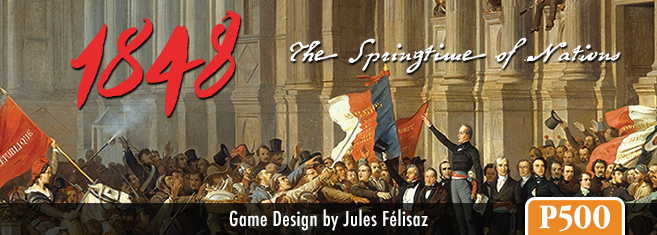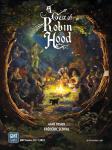![]()
![]()
![]()
![]()
![]()
![]()
1848: The Springtime of Nations
33 years after the Congress of Vienna, Continental Europe still lives under the reactionary system designed by the Austrian Prince Metternich, the dominant figure of the age. Outside of England and France, absolute monarchy is the norm—and even in the latter, Louis-Philippe, the “bourgeois king,” is busy rolling back the people’s hard-fought liberties.
In the east, the empires of the “Holy Alliance,” Austria, Russia, and Prussia, enforce ruthless repression against progressive ideas—whether nationalist, republican, democratic, liberal, or socialist. But the time is ripe for revolution, and the conflagration of 1848 will shake this old system to its core in a whirlwind of insurrection and new ideas. “People’s wars” will rage.
Do you not feel, through a kind of instinctive intuition that cannot be analyzed but that is certain, that the ground is shaking once again in Europe? Do you not feel—how shall I call it?—that a revolutionary wind is blowing?
- Alexis de Tocqueville, Souvenir (January, 1848)
The year 1848 is turning out well. By this glorious revolution the French proletariat has again placed itself at the head of the European movement. All honour to the workers of Paris!
- Friedrich Engels (1848)
1848: The Springtime of Nations is a 2-player CDG depicting the unprecedented wave of revolutionary activity that swept across Europe in the titular year of 1848. Based on the hit area control system pioneered by GMT’s 1989: Dawn of Freedom and Twilight Struggle, it pits the forces of “the Revolution” against those of the “Counter-Revolution” in a struggle to decide the future of Europe and the world.
The Revolutionary player controls the various insurgent and progressive movements trying to usher in a new order while the Counter-Revolutionary player leads the forces of reaction aiming to preserve the status quo. They will fight over and across the empires and nations of Europe, attempting to suppress their enemy’s influence and extend their own through a combination of political and military force—all the while navigating myriad historical events of the time.
Revolution and Counter-Revolution
In the early game, the Revolutionary player will have the edge with many powerful events kickstarting revolutions—particularly by dominating the favorable terrain of Bourgeois and Worker spaces in the west of the map. The Counter-Revolutionary will have to strike out from their natural base in Church and Aristocrat spaces in order to contest the proclamation of new Republics, but they can take heart in the fact that momentum will swing their way.
Nations and Empires
On the game’s map, players will find great multinational Empires at the height of their glory and burgeoning nations vying for their unity, independence, and liberty. Using the same regional scoring system as 1989, scoring regions are formed by the spaces belonging to France, Germany, Italy, Poland, and Hungary. In an original twist, however, a second set of regions is superimposed over these nations in the form of the Austrian, Russian, and Prussian empires. The result is an interlocking system of scoring regions, adding greatly to players’ strategic considerations.
Republics
Across the course of the game, the Revolutionary player will aim not only to dominate and score the different regions of the board but to strike hard enough that they can successfully establish the Revolution and declare new national Republics. These will allow the Revolutionary player to score additional Victory Points. However, to claim these, they will need to protect their new regimes from the inevitable attempts of the Counter-Revolutionary to topple them.
Class Struggle
The socio-economic canvas of 19th century Europe forms the heart of the game. Classes old and new are represented in 1848: The Springtime of Nations, from the rising bourgeoisie and proletariat driving the industrial revolution found in powerful clusters across western Europe to the agrarian east still dominated by church and aristocracy. Each nation also has its own set of intellectuals and students whose passions can be inflamed by timely agitation. Meanwhile, peasants are still to be found everywhere, but swaying them to either cause will be difficult.
Four seasons
With a dynamic deck entry system (not unlike the War Status system in GMT’s Paths of Glory), players will experience the different phases of the “formidable year” of 1848. Spring will see the ideas of the revolution spread easily across the cities of Europe, dominated by spaces representing their populations of Bourgeois and Worker. As the seasons pass however, Reaction will find more and more ways to fight back as their troops enter the fray and contradictions appear among the actors of the revolution…
A clash of arms
While 1848: The Springtime of Nations is at its core a political game, it does also include armies. The history of 1848 cannot be accurately told without its military side, including popular insurrections, the First War of Italian Independence, and ruthless suppression into 1849.
As the game progresses, the Revolutionaries will mobilize their armies as they spread east from France and Italy into Germany, Hungary, and Poland. But so too will the Counter-Revolution mobilize in an attempt to protect and consolidate their regimes. Thus, both sides will attempt to achieve by force what they cannot by influence.
The Battle of Ideas
Replacing the Space Race of Twilight Struggle and the Tiananmen Square track of 1989, ideological conflict takes the stage in 1848: The Springtime of Nations through the Battle of Ideas. Both players will try to advance their agenda on the political, national, and social questions of the age in order to gain powerful bonuses for their side.
Components:
- One 22” x 34” map board
- Two 6-sided dice
- 194 poker size cards
- 134 Strategy
- 60 Revolution
- Two counter sheets
- Seven 1” counters (Republic tokens)
- 223 5/8” counters
- 180 Influence markers
- 31 Army markers
- 12 other markers
- Two 8.5” x 11” double-sided player aids
- One rulebook (24 pages)
- One 3” box
Players: 2
Game Designer: Jules Félisaz
Game Developer: Peter Evans
| Publisher | GMT Games |
|---|
Customers who bought this product also bought:
- Service
- Information
- Brands

 Did you forget your password?
Did you forget your password?












